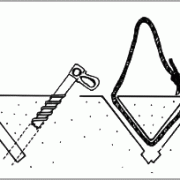How to make a V-tread
by Dave Furman
 More and more recently I’ve come across all sorts of gear left on ice climbs, left when people rap off or when people can’t finish a route and rap or lower off. In the interest of keeping the chat room posturing to a minimum and to help preserve everybody’s rack, here is how I place a V-thread and retreat from an ice climb. (I feel like I’m uniquely qualified to write this, as I have retreated off of ice climbs in fourteen states, including almost every route at lake Willoughby and in smugglers notch.) A V-thread is stronger than a screw because the surface area of the ice you are supporting your weight on is much greater than that of the threads on an ice screw. Many people don’t trust them however, so what follows is my method of backing up and testing rappel anchors in general, as well as directions for making a V-thread.
More and more recently I’ve come across all sorts of gear left on ice climbs, left when people rap off or when people can’t finish a route and rap or lower off. In the interest of keeping the chat room posturing to a minimum and to help preserve everybody’s rack, here is how I place a V-thread and retreat from an ice climb. (I feel like I’m uniquely qualified to write this, as I have retreated off of ice climbs in fourteen states, including almost every route at lake Willoughby and in smugglers notch.) A V-thread is stronger than a screw because the surface area of the ice you are supporting your weight on is much greater than that of the threads on an ice screw. Many people don’t trust them however, so what follows is my method of backing up and testing rappel anchors in general, as well as directions for making a V-thread.
Once you’ve decided you’re done, whether you’re at the top of the climb or not, you’ll want to examine your options—if there’s an easy walk-off or if there’s a shiny new bolt station nearby, obviously it may be faster and easier to frig your way over there. That never seems to happen to me, but I do run into all sorts of sketchy looking fixed anchors attached to all manner of trees, shrubs, rocks, blocks, icicles, threads, pins, etc. Usually they have eleventeen different pieces of tat all semi-equalized somehow, and it still looks sketchy. My rule of thumb is always back up my anchor—but that may not mean leaving anything behind. Often what I’ll do is create my own separate anchor, unweighted by the rappel rope through the fixed anchor, so that I have the opportunity to vigorously bounce-test the fixed one. If anything rips, I’m protected by my backup, and then can start leaving all my own gear…more likely the anchor holds even my heavily aggressive more-than-double-my-body-weight testing, and I can safely clean my backup (after my partner completes the rappel) without leaving a thing behind. I do the same thing with fixed V-threads. Place a screw or two far enough away that if the thread rips it won’t undermine your placement, and clip it to the rappel rope as well—it’s important that the rappel rope does not weight your backup anchor, or you won’t be testing the fixed one. This way, any anchor you see on the ice, as well as most tree and pin anchors, can be tested to ensure their solidity. It doesn’t hurt to carry a small knife, some extra cord or web and a couple rings to replace (not just add to) the really ratty fixed stuff.
To place a V-thread, first find the area of solid ice that has the least air pockets or cracks through it. It helps to find a small pillar or convexity, as this will aid in placing the holes for the thread. Place the longest screw you can in the ice, at an angle and location that will allow you to drill another screw to meet the first hole (the convexity allows you to place a hole on either side of it, increasing the size of the ice column in between). It is nice to leave the first screw partially in the ice so you can use it as a gauge for the correct angle and location for the second screw. You will be able to see the second screw intersect the hole from the first. Push a piece of cord or 11/16’’ web through one hole, and pull it out the other with the hook you brought with you. (This can be either a homemade job from coat hanger, or a pre-fab one—several are available, Charlet Moser makes a good one that is easily available. See directions below to make one) Tie the ends of the cord together, and you’re done. If the hole is shallow, or cracked, or hollow ice, or you’re just into public service, place a second thread 18’’ or so above the first, so that the rappel rope weights the two cords equally. If you practice, this really only takes five minutes to make a double thread anchor—I’ve often been able to place a thread between the time that my partner finishes a pitch, calls off belay and finishes constructing an anchor, and when they put me on belay.
To make a v-thread tool, get one of the all-wire heavy-gauge coat hangers from your closet, and cut a piece of wire about fourteen inches long. Bend one end to form a loop that you can clip to a carabineer. Bend the other end into a hook that will easily fit through the inside of one of your ice screws, and sharpen the point of the hook with your file. You’re done. I fold mine into a loop, hooking the hook end through the loop so it doesn’t catch on my precious gore-tex, but be careful of this as the wire will fatigue and break before too long—luckily they’re really cheap! Good luck and be safe!
See an update from Dave, and comments below


